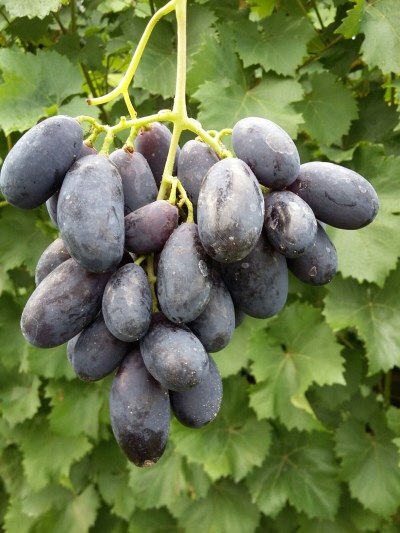
- Authors: Kalugin V.M.
- Appointment: dining room
- Berry color: blue
- Taste: harmonious, pleasant, crunchy
- Ripening period: very early
- Ripening period, days: 95-100
- Frost resistance, ° C: -23
- Bunch weight, g: 500-700
- Flower type: bisexual
- Density of the bunch: loose
Natalie grapes are distinguished by an interesting fruit shape, aesthetic appearance of the bunch and crispy, pleasant pulp. The variety is loved by summer residents for its early ripening period and unpretentious care.
Breeding history
The table hybrid appeared thanks to V.M. Kalugin.
Description
To find out whether it is worth planting Natalie grapes on your site, you should carefully study the characteristics of the variety.
Ripening period
The bushes have a very early ripening period, for which they are loved by many gardeners. The bunches mature for about 95-100 days.
Bunches
The bunch is loose, as the berries do not adhere too tightly to each other. The weight of one bunch can be from 500 to 700 g.
Due to their attractive external characteristics, the bunches are highly marketable.
Berries
Ripe fruits are blue in color, oval, with crispy flesh of high density. They are slightly elongated, in some cases they are sickle-shaped. The weight of one grape varies from 10 to 12 g, the size is about 44x22 mm.
Taste
The taste is pleasant and harmonious, there is a crunch.
Yield
The variety gives a high-quality and bountiful harvest.


Growing features
To grow a healthy, vigorous and prolific plant, you need to know about several nuances of its cultivation.
Landing
Natalie grape seedlings are planted in spring. In the southern territories, you can plant a crop in mid-March - early April. In cold regions, the bushes are planted in May. The earlier the grapes are planted, the more intensively they will develop. In winter, the culture cannot be planted, as low temperatures can harm it.
It is important to choose the right place and soil. It is best to find an area with plenty of sun and protection from strong winds. You cannot choose a place where an old bush of a different variety was previously located.
The soil should be sandy, clayey or black earth. It is prepared in advance with peat and humus in the fall.

Pollination
The flowers are bisexual, which means they do not require additional pollinators.
Pruning
There are several guidelines for pruning.
The slices should be facing the inside of the bush. This will allow the plant to heal wounds much faster.
Slices are performed in 1 movement. It is important that their surface is flat.
In the process of pruning, you should try not to damage the perennial shoots.
The arrows that are left for fruiting must be intact.
In the autumn period, arrows are revealed that are not capable of bearing fruit.They are removed, as they will pull out the elements necessary for formation and development from the bush.

Watering
To facilitate and improve the watering process, it is necessary to place the pipe in the hole before planting. The distance between it and the cuttings should be about 25-30 cm. The first end should be located at the level of the drain, the second should protrude 10-15 cm above the soil. The pipe diameter can be 8-10 cm.
This method of watering is good because moisture will penetrate directly to the roots. Under normal climatic conditions, it is necessary to water the crop once every few weeks. A sparse but abundant watering will keep the grapes healthy and strong, while frequent watering encourages weeds.


Frost resistance and the need for shelter
The variety is able to withstand low temperatures down to -23 degrees.

Diseases and pests
Natalie variety is tolerant to diseases such as:
oidium;
gray rot;
root phylloxera;
leafy phylloxera.
Grapes are resistant to major diseases and pest attacks by 3 points.
To avoid infection, preventive measures should be taken. For this, Bordeaux liquid is used, which fights well against diseases provoked by the fungus. Here are some more tips for preventing and controlling disease:
"Nitrafen" will help fight ticks, oidium and worms;
"Karbofos" is an effective drug against aphids, bedbugs, spider mites and moths;
"Oxyhom" is able to effectively fight mildew and other fungal diseases, has a long-term healing property.
Treatment with funds is carried out in early spring, before the budding process.

If a grape is exposed to any disease or insect, this always affects its appearance.
Storage
Bunches can be stored well under comfortable conditions.











































































